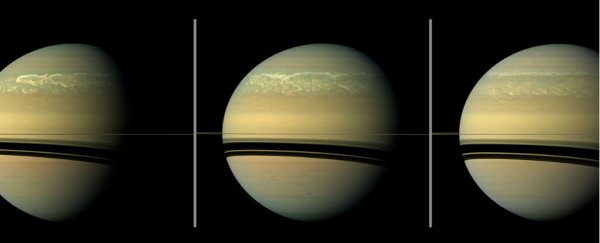Saturn's rings aren't always its most spectacular feature. About every 20 to 30 years, mysterious thunderstorms erupt in the planet's atmosphere, giving rise to Earth-sized white spots, with long tails of storms that can stretch around the entire planet.
Over 140 years of telescope observations, these incredible storms have erupted on Saturn six times, but it's unclear how they form. Now, thanks to the Cassini spacecraft, researchers at the California Institute of Technology in the US have been able to track and observe the most recent of these storms, which began in December 2010 and lasted for eight months.
Using these observations, the team developed a conceptual model to simulate the formation of these storms, which they've used to explain why they occur at such regular intervals.
In a paper, published in the journal Nature Geoscience, the researchers suggest that water vapour, trapped for decades in the planet's lower atmosphere after the storm, might be the driving force.
The basic idea is this: the water molecules in Saturn's atmosphere are heavier than hydrogen and helium, which are known to comprise the bulk of the planet's atmosphere. So after one of these epic storms dumps a huge mass of rain, the air within the clouds is left significantly lighter than the moist atmosphere below.
This situation temporarily shuts off a process known as atmospheric convection, which is responsible for generating new clouds and storms.
"For decades after one of these storms, the warm air in Saturn's deep atmosphere is too wet, and too dense, to rise," lead author Cheng Li said in a press statement. "The air above has to cool off, radiating its heat to space, before its density is greater than that of the hot, wet air below. This cooling process takes about 30 years, and then come the storms."
Co-author Andrew Ingersoll said the reason it takes so long to trigger another storm is because "the upper atmosphere is so cold and so massive."
If they're right, their findings could solve the mystery behind these strangely beautiful storms, and could also reveal new insight into how Saturn's atmosphere differs from that of its gas giant neighbour, Jupiter, and how these planets might have formed.
The relatively long intervals between these explosive tempests on Saturn could indicate that its atmosphere harbours more water vapour - relative to other atmospheric constituents - than Jupiter, which tends to have a steadier supply of less severe thunderstorms, which don't circle the entire planet.
Just thinking about epic thunderstorms on other planets is making me pretty damn happy to be an Earthling.
